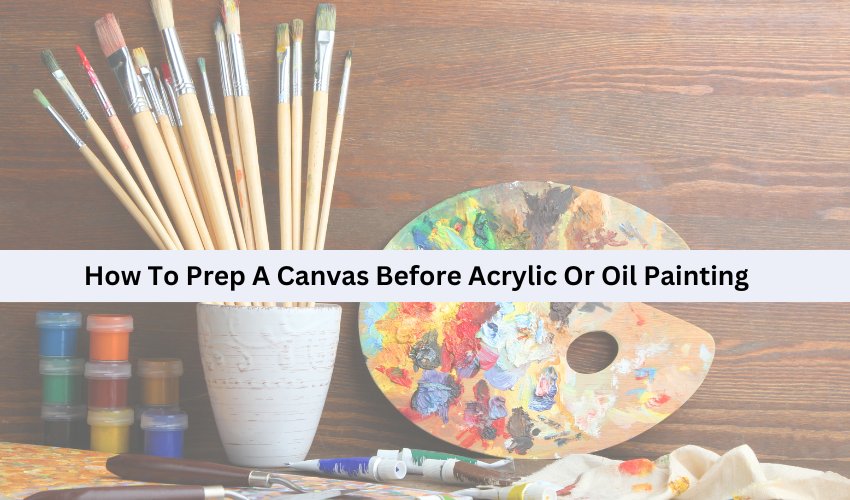How To Prep A Canvas Before Acrylic Or Oil Painting

One of the most important stages of painting in oils and acrylics is setting up a canvas. It guarantees that the paint acts as it should and that your work has a durable, tough surface for adherence. This tutorial guides you through "prepping a canvas." It explains the differences in priming between oil and acrylic paints. It details a careful method for applying the right primers.
Understanding "canvas preparation" is as important as the painting itself. Preparing the canvas properly prevents the paint from being absorbed into the fibers, which might damage them over time. It also gives the paint a smooth surface. This allows for better control and more brilliant colors.
Understanding Priming
The priming process is the application of an oil or "canvas primer for acrylic paint" to the canvas. This layer of primer blocks the paint's harmful effects on the fabric. It also prevents the fabric from rotting or becoming brittle over time. Lastly, it acts as a buffer between the paint and the canvas.
Differences in Priming for Acrylic vs. Oil Painting
The techniques used are the same for "how to prepare canvas for acrylic painting" and "preparing canvas for oil painting," but the supplies are different.
Now, the technique for painting with acrylic:
Acrylic gesso is often described as "primer paint for canvas" for acrylic paintings. Acrylic gesso is an acrylic polymer mixed with calcium carbonate and other additives. It has a medium absorbent surface, perfect for acrylic paintings.
Oil painting
You can prime oils with acrylic gesso or an oil-based primer. While acrylic gesso will dry in less time and is easier to use, traditionally, some painters hold oil priming as being more durable for "oil painting on canvas."
Steps for Applying Gesso or Oil Primer
It’s no rocket science applying oil primer, or whatever name you may call it, say "primer paint for canvas." Still, like all other facets of making a painting, it must be attended to with some attention to detail if a good result is expected.
1. Prepare the canvas
Before applying any primer, make sure the canvas is evenly stretched over the frame to ensure that the priming comes out smooth and even. A tight canvas guarantees a smooth, wrinkle-free, oil prime.
2. Canvas Size
In "oil painting on Canvas", the sizing prevents the oil in the paint from touching the canvas fibers. Rabbit-skin glue and, recently, synthetic restorations are common materials for sizing. Because acrylic gesso will readily hold onto the fabric, the sizing is not as relevant for acrylics.
3. Initial Coat with Gesso or Oil Primer
Apply a thin, full layer of gesso or oil primer over the canvas by employing a big, flat brush. Be very sure to spread the primer evenly on the canvas. Work from the middle to the outer edges. Do not apply too much at a time, for this may result in an uneven texture or drips.
4. Sand the Outside
Once the first application of primer has dried, gently sand using fine-grit sandpaper. Doing this will level out any blemishes and raise the surface slightly so that the paint will adhere to it. Be careful not to damage the canvas.
5. Add More Coats
For the best results, apply two or three coats of gesso or oil primer. “Let each coat dry completely before applying the next”. Sand gently between coats to create a great surface for paint.
Waiting Time Before Starting to Paint
You must wait for the primer to dry before painting after "prepping canvas for oil painting" or acrylic.
Acrylic painting
Acrylic gesso usually dries within hours. However, for the best results, it is advisable to wait a minimum of 24 hours before putting the first strokes of paint over it. By doing so, you can be sure that the gesso is dry and well-evaporated of all its moisture.
Oil-Based vs. Acrylic.
Oil-based primers take much more time to dry than acrylic gesso. For an "oil painting on canvas," the canvas might dry over four, or even, one week before the next step. Here, one must balance the coat thickness against the humidity. Rushing through this stage may ruin the surface and result in poor adhesion.
Sizing vs. Priming: What's the Difference?
Distinguishing the primer from the sizing is important, as both items are crucial components when it comes to "canvas preparation".
Dimensions
As mentioned above, sizing the canvas seals the fibers to protect them from the paint. Traditionally, this process is often linked to "oil painting on canvas," as the oils from the paint over time deteriorate the canvas. Sizing also helps reduce the canvas's absorbency. This, as we'll see later, is good when painted with oils.
Preparing the surface
On the other hand, priming includes the preparation of the receipt for the paint that will stick. Priming is as important as "preparing canvas for oil painting" with acrylics so the paint acts predictably to form a unified, permanent piece of working art.
Read Also: Expert Oil Painting Tips to Elevate Your Artwork
Final Words
A good painting starts with the right "canvas preparation." If you size and prime your canvas, it will be a good surface for your oil or acrylic paints. It will be both solid and durable. By learning the differences between "how to prepare canvas for acrylic painting" and "preparing canvas for oil painting," you can choose the right materials and techniques. This will help you create beautiful, timeless artwork.
Remember, "primer paint for canvas" does a great deal more than just smooth out your surface; it protects your canvas and generally elevates the standard of your work. So, take your time going through the instructions and enjoy painting on a properly prepared canvas.




